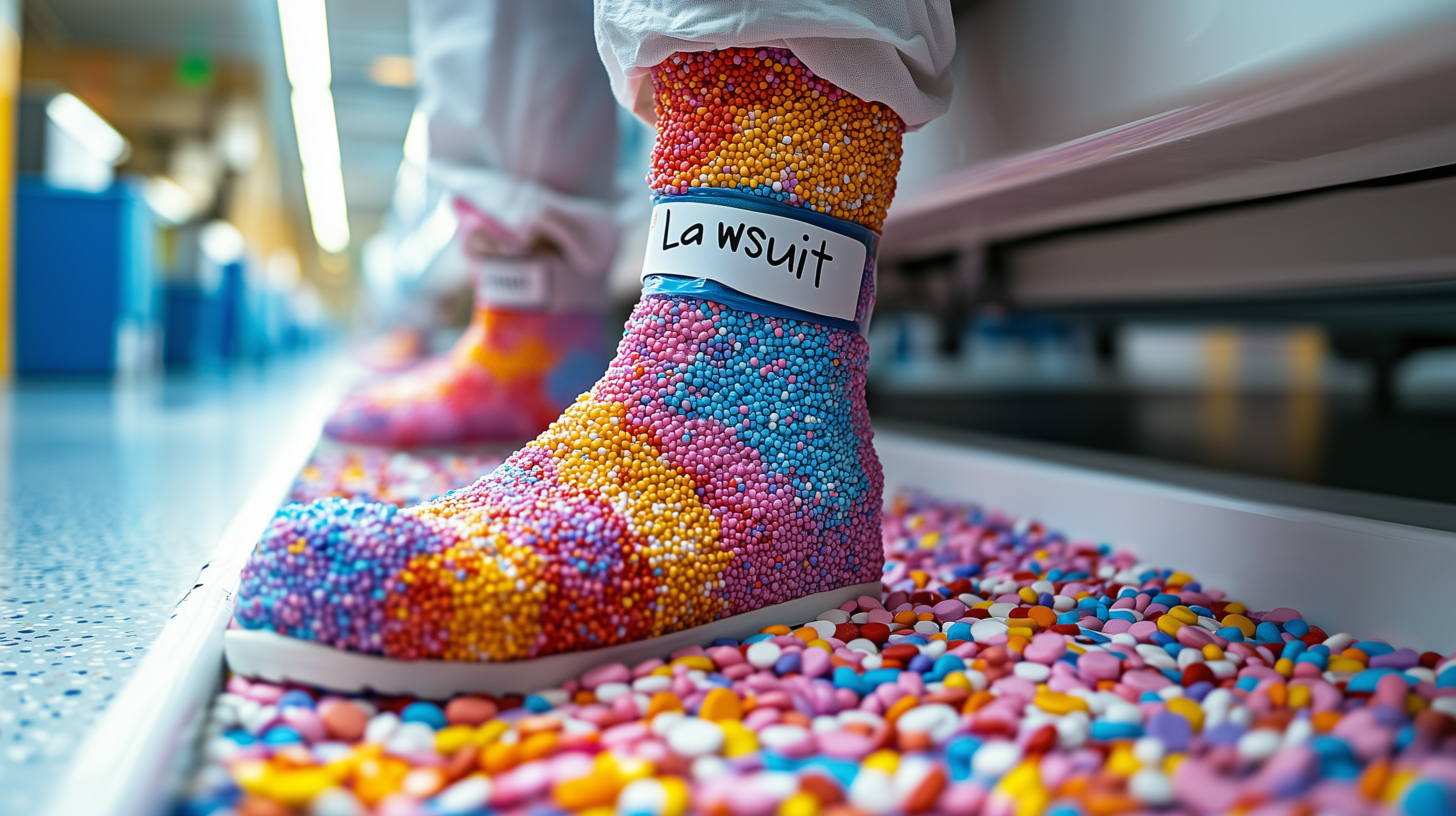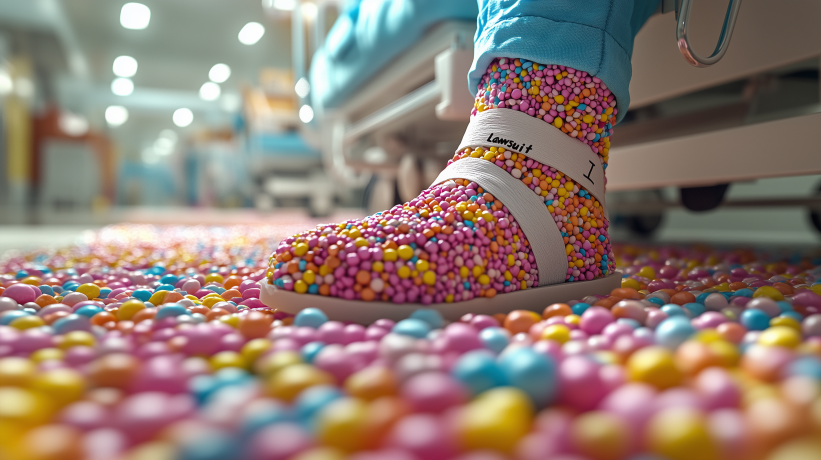
A visitor's joyful leap into the Museum of Ice Cream's sprinkle pool ended in a severe ankle fracture, prompting a lawsuit alleging negligence. The case highlights the potential dangers lurking beneath the surface of Instagram-worthy attractions and raises questions about the balance between interactive experiences and visitor safety.
by LawInc Staff
August 12, 2024
When Jeremy Shorr took his daughter to the Museum of Ice Cream in New York City on March 31, 2023, he expected a carefree day of sweet fun. Instead, he ended up with a trip to the emergency room. Shorr is now suing the popular attraction, claiming its hyped “sprinkle pool” attraction was an accident waiting to happen.
This overview breaks down everything you need to know about Shorr’s premises liability lawsuit against the Museum of Ice Cream, from the alleged negligence to the damages sought.
Whether you’re a curious museum-goer, a legal buff, or just love a scoop of litigation with your ice cream news, this easy-to-digest summary has you covered. Let’s dive into the sprinkles of this contentious case!
1. Understand the Basis of the Lawsuit
-
- Alleged Negligence: Shorr claims the Museum was careless in how it designed, developed, manufactured and maintained the sprinkle pool.
- Failure to Warn: The Museum heavily promoted the pool as safe for “diving in,” without warning of risks or providing adequate safety instructions.
- Unsafe Conditions: Shorr argues the sprinkle pool was inherently dangerous, with not enough sprinkles or padding to cushion jumps and falls.
- Prior Notice: The complaint asserts the Museum knew of sprinkle pool dangers from prior incidents but failed to take corrective action.
- Premises Liability: As a business inviting paying customers, the Museum owed Shorr a duty to maintain safe premises and warn of hazards.
Examples:
-
- Shorr’s complaint includes photos of the Museum’s website and social media showing gleeful sprinkle pool “diving” and “cannonballs.”
- A December 2021 news story reported a woman having “the wind knocked out of her” after falling in the pool.
- An August 2023 video shows a visitor badly spraining her leg in the pool, requiring her to use crutches afterwards.
- Engineering analysis concludes the pool contains an insufficient volume and depth of sprinkles to absorb the impact of jumps.
- Premises liability law requires the Museum to keep its facilities reasonably safe for visitors, such as Shorr who paid an entry fee.
Legal Issues to Watch:
-
- Was the sprinkle pool unreasonably dangerous due to its design, lack of warnings, or the Museum’s failure to maintain safe conditions?
- Did the Museum’s promotion of “diving in” negate any liability waivers Shorr may have signed by misrepresenting the pool’s safety?
- Will evidence of prior sprinkle pool incidents be admissible to show the Museum’s notice of the dangers and failure to act?
- How will the court assess comparative negligence if the Museum argues Shorr assumed the risk by voluntarily jumping in?
- What duty of care does a “novelty” attraction like the Museum owe patrons, compared to conventional business premises?
FAQs:
-
- Is the Museum liable if Shorr chose to jump in the pool himself? Possibly, if the Court finds he didn’t fully appreciate the risks due to inadequate warnings, misrepresentations about safety, or concealed dangers.
- How can Shorr prove the Museum knew the pool was dangerous? Evidence like prior incident reports, employee testimony and engineering analyses could show the Museum was on notice of hazards.
- What if the Museum claims Shorr signed a liability waiver? Waivers for recreational facilities can be voided if there is gross negligence or intent to harm. Misrepresenting safety risks may also invalidate waivers.
- Will Shorr win his case? The strength of his evidence of Museum negligence and damages will determine that. Persuasively showing the Museum failed in its duties will be key.
- What is this case’s potential impact? A plaintiff win could force attractions to strengthen safety measures and warnings. It may also clarify premises duties for novel, interactive exhibits.
2. Identify the Alleged Failures by the Museum
-
- Inadequate Design: Shorr claims the Museum failed to properly design the pool to be safe for jumping, with insufficient sprinkle depth and unsafe landing surface.
- Lack of Warnings: Despite plastering “dive in” and “take the plunge” on ads, the Museum allegedly did not properly or conspicuously warn of injury risks.
- Improper Maintenance: The complaint asserts the Museum did not keep the sprinkle pool in a reasonably safe condition or perform needed repairs.
- Insufficient Supervision: Shorr argues the Museum failed to properly monitor the pool, enforce safety rules, or react to warning signs of danger.
- Misrepresenting Safety: By promoting sprinkle pool jumping and downplaying risks, Shorr claims the Museum misled guests into a false sense of safety.
Examples:
-
- Expert analysis suggests the pool would need 3x the sprinkle volume and a trampoline-like base to make jumping reasonably safe.
- Promo videos show visitors leaping in the pool from height with no guidance from staff on how to land safely.
- Discovery may reveal repair logs or staff memos noting sprinkle loss or compression from repeated jumping over time.
- Shorr’s attorneys will likely seek records of sprinkle pool-related injuries and any investigations or responses by the Museum.
- The complaint highlights the Museum’s FAQ assuring the pool has “enough sprinkles to cushion your landing” without noting any dangers.
Why It Matters:
-
- Proving failures like inadequate design, maintenance, supervision and warnings can help establish the Museum breached its duty as a premises operator.
- Employees’ prior awareness of dangers could show the Museum ignored known hazards and did not take reasonable steps to enhance safety.
- Evidence the Museum misled guests about sprinkle pool risks may invalidate any liability waivers and support claims of gross negligence.
- Demonstrating a pattern of insufficient action in the face of problems could paint the Museum as putting profits over patron protection.
- The nature, extent and notice of safety failures will shape whether Shorr’s injuries are deemed reasonably foreseeable and preventable.
FAQs:
-
- What safety features should the Museum have implemented? Possibilities include impact-absorbing flooring, sprinkle level monitoring, capacity controls, supervision, and posted safety rules.
- How much sprinkle depth would be considered “adequate”? Experts will likely weigh in, but at least several feet may be needed, as with foam pits in gymnastics facilities.
- Does the Museum have any defense to these alleged failures? It may argue its precautions were reasonable for the intended use, or that Shorr’s own negligence caused his injuries.
- Will promotional materials touting the pool’s safety be a liability? Quite possibly, if they’re found to be misleading and to have shaped guests’ risk assessment and behavior.
- How might the Museum argue Shorr is comparatively negligent? It may contend he ignored any posted rules, jumped recklessly, didn’t assess his own abilities, or failed to notice obvious dangers.
3. Assess Shorr’s Damages Claims
-
- Severe Leg and Ankle Injuries: Shorr sustained a right bimalleolar equivalent ankle fracture requiring surgical open reduction and internal fixation.
- Medical Expenses: He has incurred bills for ER treatment, orthopedic surgery, diagnostic imaging, physical therapy, medications, and more.
- Future Care Needs: Anticipated costs of additional surgeries, ongoing therapy, orthopedic equipment, and projected care.
- Pain and Suffering: Compensation for past and future physical pain, mental anguish, emotional distress, inconvenience, and lost quality of life.
- Lost Earnings: Income lost from missed work during recovery and any reduced future earning capacity from lingering impairments.
Examples:
-
- Shorr’s medical records detail a displaced right ankle fracture, requiring immediate open reduction and internal fixation with plates and screws.
- His hospital bills total $45,000 so far, with another $120,000 in anticipated future orthopedic care and physical therapy costs.
- Shorr has already undergone two surgeries, has significant pain and limited mobility, and will likely need an ankle fusion or replacement in the future.
- A father of three, Shorr has been unable to work for 4 months and may need to change careers dueto permanent limitations, resulting in substantial lost earning capacity.
- His injuries have significantly diminished his quality of life, leaving him unable to play with his kids, exercise, or enjoy his former hobbies.
Damage Assessment Tips:
-
- Gather all medical bills and records detailing Shorr’s specific diagnoses, treatment, and prognosis to prove the extent of harm.
- Have medical experts review the records and prepare reports on the necessity of care, permanent impairments, and future medical needs.
- Document all out-of-pocket expenses like medical supplies, medications, transportation to appointments, and home or vehicle modifications.
- Calculate lost income to date and work with a vocational expert to estimate future lost earning potential based on Shorr’s age, occupation, and limitations.
- Keep a journal of pain levels, emotional distress, lifestyle impacts, and lost opportunities to support a case for significant non-economic damages.
FAQs:
-
- What is a bimalleolar equivalent ankle fracture? A severe break of the ankle involving both lower leg bones (tibia and fibula), often from a rotational injury.
- Why does this injury require surgery? Displaced bimalleolar fractures are unstable and must be surgically reduced and fixated for proper alignment and healing.
- How can Shorr prove his future medical needs? Expert physicians can testify to his anticipated care based on the severity of injury, healing progress, and typical prognosis.
- What factors influence the value of pain and suffering damages? The nature, duration and severity of injuries, resulting limitations, and emotional impacts all affect non-economic damage awards.
- Can Shorr recover lost earning capacity even if he returns to work? Yes, if his injuries will prevent him from achieving his pre-accident career trajectory and peak earning potential.
Summary

Did You Know? The Museum of Ice Cream has faced controversy before, with environmental concerns raised over the use of plastic sprinkles in its attractions. This premises liability case adds a new legal dimension to the popular attraction’s challenges.
The Museum of Ice Cream faces serious legal exposure in this high-stakes premises liability case, with severe injuries and compelling arguments of negligence. As the litigation unfolds, expect key issues to include:
– The reasonableness of the sprinkle pool’s design, maintenance, and safety measures
– Whether the Museum failed to warn guests of foreseeable dangers
– If the Museum’s advertising misrepresented risks and contributed to Shorr’s injuries
– The full scope and lasting impact of Shorr’s economic and non-economic damages
Given the public interest and potential precedent, this will be a case to watch closely. The outcome may impact not just the popular Museum, but the legal duties of similar interactive attractions in an era of Instagram-driven “immersive” experiences.
Test Your Museum of Ice Cream Lawsuit Knowledge
Questions: Premises Liability Basics
-
- 1. What duty of care does a business generally owe to patrons on its premises?
- A) None
- B) Maintaining safe conditions to a level of reasonable care
- C) Absolute duty to prevent all injuries
- D) Duty only to patrons who sign a waiver
- 2. When is a property owner liable for injuries on their premises?
- A) Whenever someone gets hurt
- B) Injury + failure to take reasonable precautions
- C) Never, if they have insurance
- D) Whenever the injured person sues
- 3. What is an “attractive nuisance”?
- A) An annoying but irresistible feature
- B) A condition that draws in trespassers
- C) A danger likely to attract children
- D) An eyesore on the property
- 4. How can businesses try to limit their premises liability?
- A) Have patrons sign liability waivers
- B) Regularly inspect for hazards
- C) Warn guests of dangers
- D) All of the above
- 5. When might a liability waiver be invalidated?
- A) The business shows gross negligence
- B) The waiver contains vague language
- C) The injury is very severe
- D) The patron says they didn’t read it
- 1. What duty of care does a business generally owe to patrons on its premises?
Answers: Premises Liability Basics
-
- 1. B) Businesses owe customers and guests a duty of reasonable care to maintain safe premises.
- 2. B) Property owners who fail to take reasonable precautions and someone gets hurt as a result, are liable.
- 3. C) An “attractive nuisance” is a hazardous property condition likely to attract children who can’t appreciate the danger.
- 4. D) Waivers, inspections, and warnings can all help limit a business’s premises liability exposure.
- 5. A) Liability waivers may not be enforced if the business shows gross negligence in maintaining premises.
Questions: Museum of Ice Cream Case Specifics
-
- 1. What does Shorr allege caused his injuries at the Museum?
- A) Slipping on a wet floor
- B) Tripping over another patron
- C) Jumping into the sprinkle pool
- D) Eating too much ice cream
- 2. What theory of liability is Shorr primarily pursuing?
- A) Negligence and premises liability
- B) Strict product liability for a defective pool
- C) Intentional misconduct by the Museum
- D) Breach of an implied contract
- 3. How does Shorr argue the Museum was negligent?
- A) Failing to maintain a safe sprinkle pool
- B) Not warning of sprinkle pool dangers
- C) Promoting unsafe jumping and “diving”
- D) All of the above
- 4. What key evidence does Shorr cite of prior notice to the Museum?
- A) A waiver he signed noting pool risks
- B) News stories of other guests getting hurt
- C) The pool designer’s safety warnings
- D) His own prior complaints to the Museum
- 5. How much is Shorr seeking in damages?
- A) $50,000
- B) $500,000
- C) $5 million
- D) The complaint doesn’t specify
- 1. What does Shorr allege caused his injuries at the Museum?
Answers: Museum of Ice Cream Case Specifics
-
- 1. C) Shorr was injured when he jumped into the Museum’s sprinkle pool.
- 2. A) The lawsuit alleges the Museum was negligent in how it maintained and operated the premises.
- 3. D) Shorr argues the Museum failed to keep the pool safe, warn of hazards, and encouraged dangerous jumping.
- 4. B) The complaint points to prior news reports of other guests getting hurt in the pool.
- 5. D) So far, the complaint does not list a specific dollar amount demanded in damages. The full value of the claim will likely be developed as the litigation proceeds and the scope of damages is fleshed out.
Need Legal Help?
If you need legal assistance, in any field of law, our free concierge service can connect you with experienced attorneys in any practice area and state. Contact us to learn more.
Also See
Scrambled Logic: Why the Court Tossed the “Farm Fresh Eggs” False Ad Suit Against Kroger
Instagram on Trial: Teens Sue Meta for $5B in Landmark Addiction Case
Musk vs. Altman: Round 2 – The Heavyweight Legal Battle for AI’s Soul










